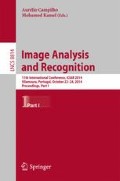Abstract
Driver distraction and fatigue are considered the main cause of most car accidents today. This paper compares the performance of Random Forest and a number of other well-known classifiers for driver distraction detection and recognition problems. A non-intrusive system, which consists of hardware components for capturing the driver’s driving sessions on a car simulator, using infrared and Kinect cameras, combined with a software component for monitoring some visual behaviors that reflect a driver’s level of distraction, was used in this work.
In this system, five visual cues were calculated: arm position, eye closure, eye gaze, facial expressions, and orientation. These cues were then fed into a classifier, such as AdaBoost, Hidden Markov Models, Random Forest, Support Vector Machine, Conditional Random Field, or Neural Network, in order to detect and recognize the type of distraction. The use of various cues resulted in a more robust and accurate detection and classification of distraction, than using only one. The system was tested with various sequences recorded from different users. Experimental results were very promising, and show the superiority of the Random Forest classifier compared to the other classifiers.
Access this chapter
Tax calculation will be finalised at checkout
Purchases are for personal use only
Preview
Unable to display preview. Download preview PDF.
References
Distracted driving, http://www.cdc.gov/Motorvehiclesafety/Distracted_Driving/index.html
Microsoft kinect face tracking, http://msdn.microsoft.com/en-us/library/jj130970.aspx
Breiman, L.: Random forests. Machine Learning 45(1), 5–32 (2001)
Butakov, V., Ioannou, P., Tippelhofer, M., Camhi, J.: Driver/vehicle response diagnostic system for vehicle following based on gaussian mixture model. In: 2012 IEEE 51st Annual Conference on Decision and Control (CDC), pp. 5649–5654. IEEE (2012)
Connor, J.T., Martin, R.D., Atlas, L.E.: Recurrent neural networks and robust time series prediction. IEEE Transactions on Neural Networks 5(2), 240–254 (1994)
D’Orazio, T., Leo, M., Guaragnella, C., Distante, A.: A visual approach for driver inattention detection. Pattern Recognition 40(8), 2341–2355 (2007)
Holahan, C.J.: Relationship between roadside signs and traffic accidents: A field investigation, Research Report 54. Council for Advanced Transportation Studies, Austin, TX (1977)
Liang, Y., Reyes, M.L., Lee, J.D.: Real-time detection of driver cognitive distraction using support vector machines. IEEE Transactions on Intelligent Transportation Systems 8(2), 340–350 (2007)
Murphy-Chutorian, E., Doshi, A., Trivedi, M.M.: Head pose estimation for driver assistance systems: A robust algorithm and experimental evaluation. In: IEEE Intelligent Transportation Systems Conference, ITSC 2007, pp. 709–714. IEEE (2007)
Pohl, J., Birk, W., Westervall, L.: A driver-distraction-based lane-keeping assistance system. Proceedings of the Institution of Mechanical Engineers, Part I: Journal of Systems and Control Engineering 221(4), 541–552 (2007)
Smith, P., Shah, M., da Vitoria Lobo, N.: Determining driver visual attention with one camera. IEEE Transactions on Intelligent Transportation Systems 4(4), 205–218 (2003)
Stanton, N.A., Salmon, P.M.: Human error taxonomies applied to driving: A generic driver error taxonomy and its implications for intelligent transport systems. Safety Science 47(2), 227–237 (2009)
Torkkola, K., Massey, N., Wood, C.: Driver inattention detection through intelligent analysis of readily available sensors. In: Proceedings of the The 7th International IEEE Conference on Intelligent Transportation Systems, pp. 326–331. IEEE (2004)
Author information
Authors and Affiliations
Corresponding author
Editor information
Editors and Affiliations
Rights and permissions
Copyright information
© 2014 Springer International Publishing Switzerland
About this paper
Cite this paper
Ragab, A., Craye, C., Kamel, M.S., Karray, F. (2014). A Visual-Based Driver Distraction Recognition and Detection Using Random Forest. In: Campilho, A., Kamel, M. (eds) Image Analysis and Recognition. ICIAR 2014. Lecture Notes in Computer Science(), vol 8814. Springer, Cham. https://doi.org/10.1007/978-3-319-11758-4_28
Download citation
DOI: https://doi.org/10.1007/978-3-319-11758-4_28
Published:
Publisher Name: Springer, Cham
Print ISBN: 978-3-319-11757-7
Online ISBN: 978-3-319-11758-4
eBook Packages: Computer ScienceComputer Science (R0)

